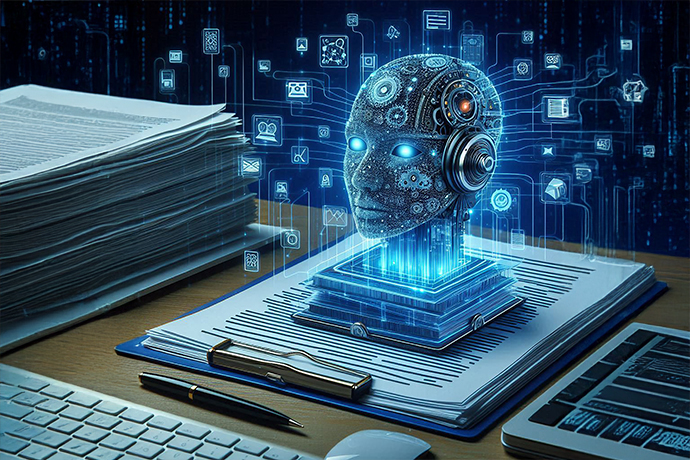 SPEAKERS
SPEAKERS
 TOPICS
TOPICS
Discover how artificial intelligence works, its learning processes, and the role of neural networks. Understand AI's potential with insights from leading experts.

In today's rapidly evolving world, the question of how does artificial intelligence work sparks curiosity. With each advancement, the boundaries between human capabilities and technological innovations blur ever further, offering a rich tapestry of discovery for curious minds. AI represents an exciting crossroads where imagination meets reality, pushing the limits of what we once thought machines could achieve.
At its core, what is artificial intelligence / machine learning? It's a field of computer science that emulates human intelligence in machines. From self-driving cars to voice assistants, AI exists to make our lives more convenient and efficient. AI systems perform tasks typically requiring human intelligence, such as visual perception, speech recognition, decision-making, and language translation. This emulation of human cognition in machines pushes boundaries, creating tools that can comprehend, reason, and process information autonomously.
The fascinating aspect is that AI can learn and adapt, constantly improving itself. By analysing massive datasets, AI develops patterns and enhances its capabilities, akin to how humans gather knowledge and improve from experience. It doesn’t stop there—the more data AI processes, the more its predictive accuracy and decision-making abilities improve.

The journey of how does artificial intelligence learn resembles a child's learning curve. Primarily, AI uses a method called machine learning, where algorithms are fed vast amounts of data. It identifies patterns and adjusts its behaviour, much like humans acquiring new skills. This intricate process allows AI to continually evolve and adapt, transforming raw data into actionable insights and intelligent reactions.
The core of AI learning lies in its ability to process information through various methodologies. Machine learning encompasses several techniques that enable AI systems to become more efficient and effective. These methods are designed to simulate the cognitive functions that humans naturally possess, fostering an environment of constant growth and refinement. They are:
The understanding of how does artificial intelligence learn is foundational in appreciating the broader spectrum of AI's potential. By decoding these processes, we can foresee a future where AI not only supports but also enhances human ingenuity, bridging gaps and unlocking new avenues for innovation and discovery.
One may ponder, does all AI use neural networks? Not entirely, but they play a significant role. Neural networks, mimicking human brain operations, allow AI to engage in complex processes like image and speech recognition. These networks consist of interconnected nodes, forming layers that process input data, extract meaningful patterns, and produce outputs intelligently. They form multiple layers, enabling deep learning, a subset of machine learning, to process more nuanced data.
The true power of neural networks comes to light through their ability to learn from data. They adapt and refine their connections based on the input they receive, much like how neurons in the human brain adjust through experience. This makes them invaluable for tasks such as natural language processing, translating languages, and even creating art. As data traverses these layers, neural networks can discern intricate patterns and representations, effectively mimicking cognitive processes.
Notably, Adam Cheyer, a pioneer in AI, sheds light on these neural systems' transformative capabilities. His insights reveal how technology is redefining our interactions with machines. The evolution of neural networks promises not only to enhance the efficiency of AI applications but also to inspire new ways of thinking about how machines can assist humans.

This brings us to an intriguing question: is artificial intelligence intelligent? While AI showcases remarkable abilities, it doesn’t possess consciousness or emotional intelligence like humans. It's logic-driven and data-oriented, focusing on task efficiency and problem-solving with precision. AI processes information tirelessly, relying on algorithms and vast data sets to derive insights and execute complex tasks at speeds no human could match.
Moreover, AI’s intelligence is often task-specific. It excels within defined parameters but struggles outside its trained scope. It can interpret trends and predict outcomes, yet lacks the intuition or creativity inherent in human beings. This makes AI formidable in areas such as data analysis, pattern recognition, and operational logistics, but limited in softer, interpersonal skills.
Renowned AI speakers often explore AI’s limitations and opportunities, inspiring us to view technology as an ally in navigating future challenges. These discussions highlight the importance of ethical considerations and mindfulness in AI development, shaping a future where AI complements human effort rather than replacing it.
Delving deeper into how does artificial general intelligence work, or AGI, we peer into AI that could potentially match human intelligence in all aspects. Unlike current AI that excels in specific tasks, AGI represents a holistic approach, addressing diverse challenges effectively. Imagine a future where machines possess the ability to comprehend, learn, and apply knowledge as broadly as humans do. This leap doesn't simply aim for proficiency in isolated tasks but strives to mirror the complex adaptability of the human brain.
Aditi Subbarao, an emerging voice in AI, explores the prospects and ethical dimensions of AGI. Her dialogue enriches our understanding of how human-like AI could redefine industries.
As we stand on the brink of profound technological shifts, discussions with technology speakers such as Adrienne A. Harris become invaluable. They guide us through AI's transformative potential, encouraging us to embrace innovations thoughtfully and responsibly. Emphasising deliberate innovation, these dialogues underscore the necessity for balanced progress, where enthusiasm for technological excellence meets the wisdom of ethical stewardship.
In addition, Adolfo Fernandez-Sanchez provides diverse perspectives, shaping our aspirations and strategies in harnessing AI’s capabilities for societal benefit. His insights prompt a reflection on the role of AGI in societal progression, urging a symbiotic evolution where technology harmonises with human values and aspirations.
The journey of understanding artificial intelligence is as dynamic as the field itself. Each step unveils new possibilities, urging us to continue exploring and imagining the unimaginable. As AGI inches closer from the realm of theory to reality, each discovery shapes and reshapes our outlook. With every stride, AGI encourages us to rethink the boundaries of what artificial entities can achieve, steering conversations that inspire visions of collaborative futures.